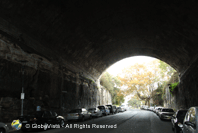 The Argyle Cut is located on Argyle Street at The Rocks in Sydney. What exactly is the cut? Well, it’s a deep rock cutting through sandstone, which provides access between Millers Point and The Rocks.
The Argyle Cut is located on Argyle Street at The Rocks in Sydney. What exactly is the cut? Well, it’s a deep rock cutting through sandstone, which provides access between Millers Point and The Rocks.
During the 1840’s Millers Point had developed into a thriving warehouse and wholesaling community but was only accessible via Kent Street, a rather tedious journey. The steep ridge of Observatory Hill blocked easy access to the area.
In 1843 the government decided to create a direct link to Millers Point from The Rocks by cutting through the sandstone ridge. The enormous job was given to convicts, who would have been none too impressed. To make matters worse they were given only primitive tools to dig into the sandstone. I guess the progress was slow as the job was eventually completed between 1867-1868 by the Sydney Municipal Council.
In an article in the Australian Town and Country Journal (1896) an old lady living in the area described its construction “I was a small girl when it began, but I used to see the convicts working, with the broad arrow on them; aye poor fellows, they would not try to hurry it – why should they? I remember later when it was a very rickety bridge over, and a bad black place it was. Once I used to climb up the hills nearly on my hands and knees it was so steep.”
 The council switched from convict labour to explosives to blast much of the sandstone away. Overhead bridges were built in the 1860s for Gloucester Street, Cumberland Street, and Princes Street but were later removed after Gloucester and Cumberland Streets were re-aligned between 1911-12 and the Bradfield Highway was constructed in the 1920s. One single bridge (at Cumberland Street) and the Argyle stairs were constructed to replace the structures. The Cut was also widened during the construction of the Sydney Harbour Bridge .
The council switched from convict labour to explosives to blast much of the sandstone away. Overhead bridges were built in the 1860s for Gloucester Street, Cumberland Street, and Princes Street but were later removed after Gloucester and Cumberland Streets were re-aligned between 1911-12 and the Bradfield Highway was constructed in the 1920s. One single bridge (at Cumberland Street) and the Argyle stairs were constructed to replace the structures. The Cut was also widened during the construction of the Sydney Harbour Bridge .
The name Argyle was chosen by Governor Macquarie in honour of his birthplace in Scotland. Many streets, buildings and places at The Rocks bear the name including Argyle Stores , Argyle Place, and Argyle Street.
The large sandstone blocks taken from the cut were used for buildings such as the Hero of Waterloo.

The Cut was widened during the construction of the Sydney Harbour Bridge
